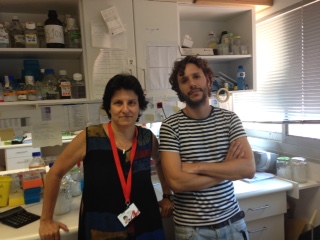Researchers from the Human Molecular Genetics at
IDIBELL, led by Mercè Pérez, of the Autonomous University of Barcelona and the CIMA Clinic of Navarra, has identified two small organic compounds that compete with NFATc to join in the same place calcineurin protein and that could have a potential immunosuppressive effect.
Activation of the immune response caused by T cell activation is the end result of a set of responses mediated by multiple signaling pathways, including calcineurin to NFATc transcription factors. Receptor stimulation of T cells produces a marked increase in calcium concentration in the cell, causing it activates calcineurin phosphatase. Once active, dephosphorylated calcineurin their substrates, including transcription factors and NFATc therefore NFATc translocates to the nucleus where it activates gene expression and production of cytokines and chemokines, which leads to activation of T cells and immune response.
Researchers have observed that these compounds prevent the NFATcs activated and therefore not induce the expression of genes of cytokines and chemokines such as interleukin-2, gamma interferon and CSF2, keeping inactive human CD4 + T lymphocytes and not activated, therefore, the immune response.
Mercè Pérez pointed out that “as opposed to the current immunosuppressants cyclosporin A and FK506 (or tacrolimus) which inhibit calcineurin activity towards all substrates, these two compounds do not affect the phosphatase activity of calcineurin to other various substrates NFATcs”. Therefore, researchers believe that the side effects of these two compounds will be much lower than current immunosuppressants.
These results may improve future clinical tolerance of immunosuppressants for patients on immunosuppressive therapy and in organ transplantation and the treatment of autoimmune diseases. Furthermore, these compounds may also be useful in treating diseases where calcineurin pathway is deregulated-NFATc as cancer.
Referencia del artículo
Matsoukas MT1, Aranguren-Ibáñez A2, Lozano T3, Nunes V4, Lasarte JJ3, Pardo L5, Pérez-Riba M6. Identification of small-molecule inhibitors of calcineurin-NFATc signaling that Mimic the PxIxIT motif of calcineurin binding partners. Sci Signal. 2015 Jun 23; 8 (382): ra63. doi: 10.1126 / scisignal.2005918.

